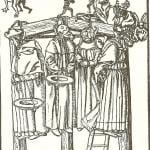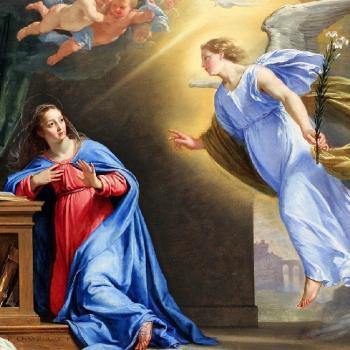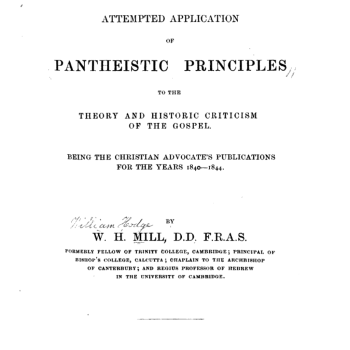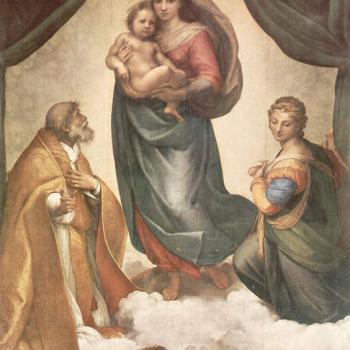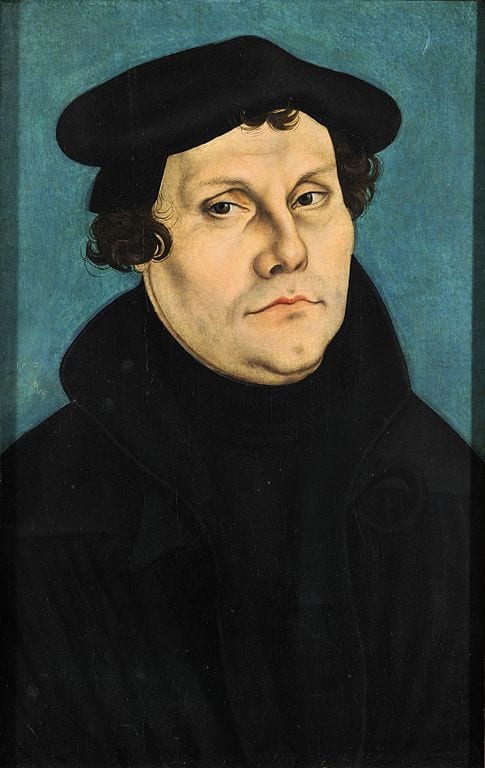
This is greatly abridged version of the original lengthy paper (dated 6-28-03). It was a rebuttal of Anti-Catholic Reformed Protestant polemicist James Swan’s paper, Luther’s Theology of Mary: A Response to Catholic Apologist Dave Armstrong (June 2003), which was in response to my paper, Counter-Reply: Martin Luther’s Mariology (Particularly the Immaculate Conception): Has Present-Day Protestantism Maintained the “Reformational” Heritage of Classical Protestant Mariology? (+ Part II | Part III), which was a reply to his 2003 article, “Martin Luther’s Theology of Mary.”
Swan’s words will be in blue. The tedium involved in dismantling one of these efforts from Swan is beyond description. I have constructed this abridged version in order to preserve the most significant and interesting parts, while sparing readers the indescribable agony of wallowing through the mud of Swan’s sophistry, excruciating obfuscation, and juvenile, and repetitive, misguided personal attacks.
*****
Interestingly though, when it comes to the topic of Mary, Roman Catholic sentiment towards Luther shifts considerably. Luther becomes the staunch supporter of Mary; a leader that all contemporary Protestants should learn a great lesson in Mariology from. This drastic shift is puzzling; particularly since Luther’s abandoning of the intercession of the saints and his doctrine of justification significantly changes his Marian approach.
I don’t see why it should be “puzzling” at all. Luther’s Mariology is much closer to the Mariology of Catholicism than that of Protestantism, even of his own branch of it: Lutheranism. This is what a Catholic finds interesting and of note. It’s one of those fascinating tidbits of history that makes the study of history so enjoyable.
Furthermore, it follows that if “going back to one’s roots” and being a so-called “Reformation Protestant” are worthwhile endeavors (it is for many thoughtful, historically conscious Protestants today), then I think it is significant that Protestantism has largely rejected the Mariology of Luther and other early Protestants (the shift with regard to the perpetual virginity of Mary is a particularly striking evolution of doctrine within Protestantism — in most cases today a 180-degree reversal).
As for Luther’s stance on intercession of the saints, I have already long since acknowledged that this is a difference from the Catholic view, but (in my opinion) not enough of a difference to make his Mariology closer in content to current Protestant Mariology than to Catholic Mariology.
This paper is a response to the multiple versions of Dave Armstrong’s “Counter Reply: Martin Luther’s Mariology (Particularly the Immaculate Conception).” Currently, I have three different versions of Mr. Armstrong’s response to my paper, varying in layout and content. Perhaps with the ever-changing nature of Mr. Armstrong’s web page response, we can expect to see further editing.
I find this very amusing. The first version lasted only two days, and was modified after I discovered I had made a significant mistake, so the earlier versions are now irrelevant. I uploaded the paper on April 24th. I edited it two days later, also adding some new material and re-organizing it. It’s called “editing.” It’s called “refining.” A single change within two days somehow gets described as “ever-changing”?
It is my contention that Mr. Armstrong’s material on Luther’s theology of Mary reflects an extreme position: the great Reformer was primarily in agreement with Rome in both doctrine and practice, with only minor conflict.
I would say that my view and approach to this topic is more so the belief that Luther’s Mariology is closer in content and spirit to Catholicism than to present-day Lutheranism (and far closer, compared to present-day Protestantism-in-general). In other words, I am examining its relative position between the two camps, not simply the Catholic camp. I fail to see how this position is extreme.
I believe my contention here is rather obvious. Luther believed in a slightly modified form of the Immaculate Conception. He believed in Mary’s Assumption. He believed in her perpetual virginity. He freely called her “Mother of God” (Theotokos). He spoke of honoring her, and preached eighty Marian sermons.
Most Protestants today deny the first three tenets outright, are reluctant to say “Mother of God” (usually due to Nestorian tendencies and a misunderstanding of what the term means, and how it historically developed), “honor” Mary (if at all), only at Christmastime or during sentimental moments while singing Silent Night, and preach and talk about her hardly at all (I don’t recall ever hearing a Marian sermon in my 13 years as an evangelical Christian).
Yet Mr. Swan would have us believe that my view is “extreme” in simply asserting that Luther’s views are closer to Catholicism than Protestantism? It’s a strange world . . .
Mr. Armstrong attempts to use O’Meara and Lortz to deny this growth and development.
My paper sees Luther as a gifted thinker whose theology grew and developed, rather than a man whose later years were plagued by incoherence and ravings.
I utterly deny the first comment and agree with the first clause of the second comment. I think Luther’s “incoherence and ravings” spanned his entire lifetime. The two are not mutually exclusive. As a serious theologian, his thought developed and expanded. The other aspect (second clause above) had mainly to do with his portrayal of Catholicism and Catholics.
His caricatures of Catholic doctrine and practices became more outrageous and vulgar as he grew older. But that is a different thing from his own theology. So I say that both aspects are true. I need not deny either. It’s a false dichotomy.
I have not offered no support for my opinions about the “contradictory” Luther. I cited Roland Bainton (author of probably the most well-known biography of Luther: Here I Stand), who showed that Luther developed, but was also “an irascible old man, petulant, peevish, unrestrained, and at times positively coarse.”
Likewise, elsewhere I cited a Protestant scholar, Mark U. Edwards, Jr. and his book, Luther’s Last Battles: Politics and Polemics, 1531-1546 (Ithaca, New York and London: Cornell University Press, 1983). Writing about Luther’s work, Against the Papacy at Rome, Founded by the Devil (March 1545), Edwards states:
The last major polemic of Luther’s life . . . was intended to inform Protestants of the true horror of the papal antichrist and to discredit the council convened at Trent . . . Without question it is the most intentionally violent and vulgar writing to come from Luther’s pen. (p. 163)
Luther even commissioned Lucas Cranach to do a series of eight cartoons to give graphic expression to his evaluation of the papacy. He provided instructions for what the cartoons were to show and penned satirical verses to accompany them. The violence and vulgarity of the treatise carried over to the cartoons . . . And he continued:
Next one should take the pope, cardinals, and whatever servants there are of his idolatry and papal holiness, and rip out their tongues at the roots (as blasphemers of God) and nail them on the gallows. . . Next, let them hold a council or whatever they want on the gallows or in hell.
One of the cartoons depicts the pope and cardinals, and their tongues, being treated in just this brutal fashion . . . Another example, this one of the vulgarity with which Luther felt the papacy should be treated, came in his discussion of the keys . . . ‘In addition, we may in good conscience,’ he wrote, ‘take his coat-of-arms, which features the keys, and his crown to the privy and use them to relieve our needs [and] afterwards throw them into the fire (it would be better if it were the pope himself).’
The associated cartoon shows a peasant defecating into the papal tiara while two other peasants await their turn . . . A third cartoon shows the Pope and three cardinals being expelled from the anus of a female devil while three furies are nursing and caring for three infant popes. The cartoon was titled ‘origin of the pope’ and was a graphic echo of Luther’s assertion in his treatise that the pope had been born from the devil’s behind . . . (pp. 189, 199)
Roland Bainton describes this “art” (my quotation marks) as “outrageously vulgar . . . in all of this he was utterly unrestrained” (Here I Stand: A Life of Martin Luther, New York: Mentor, 1950, 298).
I pointed out that “Luther did indeed have a Mariology.” Mr. Armstrong though seems to think I am denying that Luther (and the Reformers) had a Mariology.
No; I denied Mr. Swan’s assertion that Luther’s Mariology was closer to Protestantism than to Catholicism. That was my underlying thesis, and the one which Mr. Swan so strongly (but curiously and strangely) disavows. It is not the same statement as “denying that Luther . . . had a Mariology.” It’s a matter of degree rather than “existence vs. nonexistence.” Mr. Swan apparently thinks I am special pleading and distorting the historical picture for Catholic polemical reasons.
I need not distort anything. I think history clearly tells us (above and beyond scholarly disagreements on various details) that Luther and also the other early Protestant leaders were far more interested in and devoted to Mary than present-day Protestants. Mr. Swan can “work around the edges” of this truth but it won’t change the fact.
Mr. Armstrong’s approach to Luther is an excellent example of the “drastic shift” I noted above. When Luther makes positive comments in regard to Mary, Luther is seen as a positive theological beacon that all Protestants should flock towards.
Here we go with the melodramatic words again. First, we had “extreme,” now “drastic.” My views are neither, as far as I am concerned. First of all, the argument at a deeper level is a comment on the internal dynamics of Protestantism, with regard to the relationship of current Protestants to their origins (perhaps this aspect was misunderstood — my arguments against Protestantism often are, because Protestants are so completely unacquainted with such vigorous critiques and Catholic modes of thinking and argumentation are very foreign to them):
1) Luther founded Protestantism.
2) Many Protestants today are seeking to revisit, incorporate, or re-establish the “Reformation heritage.”
3) Part of that heritage is Luther’s Mariology, which is far more robust than present Protestant Mariology.
4) Protestants ought to ponder why this is, and consider that it may suggest that there is a bit more to Catholic distinctives than meets the eye, seeing that Luther’s principle was sola Scriptura, not adherence to all dogmas of the Catholic Church.
Secondly, I don’t see why it is somehow a questionable notion that Catholics would commend Luther when his views are similar or identical to theirs. After all, Protestants do this all the time in their polemics, the other way around. They will quote some Catholic or a Church Father whom they think sounds like a Protestant (St. Augustine is routinely utilized in this way).
They will extol him to the heavens. But when the same person speaks in some shockingly Catholic way (say, about purgatory or allegiance to the pope), then he is (rhetorically) cast off like a pair of dirty socks. Protestant histories of the early Church are often typified by this love-hate relationship with early Christians.
Philip Schaff, in particular, comes to mind. He will often praise the “Protestant” elements of some Father and then immediately rail against the “Catholic” stuff that was widespread at the time — to his obvious dismay and bewilderment. Schaff is quite opinionated, but he sticks to facts and tells it like it was, which is why I like him so much. When Luther is right, the Catholic will commend him! That this is an amazing, “drastic” phenomenon is “extremely” curious to me. It’s just common sense. Truth is truth.
Why is it that when Luther speaks about Mary, anybody should listen?
Protestants should listen, because he is the founder of their system and highly respected by them. The more relevant question, in my mind, would be, “why should Protestants ignore Luther when he teaches about Mary, and why should they paternalistically dismiss his Mariology as, e.g., an unfortunate ‘holdover’ from the Catholicism that he only recently emerged out of?”
It is hard to take Mr. Armstrong’s views on Luther seriously.
One wonders, then, why such a huge paper (the longest direct response to my work that I have yet encountered) is devoted to them . . .
In my description of the medieval climate and Luther’s own admission of partaking in Mariolatry (while a faithful son of the Catholic Church), Mr. Armstrong’s charges that I put forth a “Cardboard Caricatures of Medieval (and Orthodox Catholic) Marian Piety.”
Indeed I did, and rightly so, for Mr. Swan made absurd statements like the following:
Mary had taken the role of intercessor, co-redeemer, and had been elevated to the status of a “goddess” who would defeat Satan. She had become an idol. In the worship of idols, there is no salvation.Mary takes on the attributes of Christ and thus becomes an idol . . .
While Luther could call Mary the “Mother of God,” he was far more concerned to say something about the work of God in Christ than about her, thus, he un-deified her by definition. His usage was not intended to be a quasi-divine statement of veneration similar to medieval or current Roman Catholic trends. When Luther abandoned aspects of Mariology like the Immaculate Conception, it served to further un-deify the goddess . . . making sure that Mary was not to be deified . . .
Her attributes were worshipped in order to gain her favor.
He saw that she had been adorned with attributes that only belonged to Christ.
What Mr. Armstrong fails to do in these criticisms is to put forth doctrinal standards of Marian piety within the Sixteenth Century to correct my (alleged) caricature.
That’s not my task. Rather, it is Mr. Swan‘s task to show that any of these absurd claims can be demonstrated by official Catholic teaching. I say that they cannot. The burden of proof is on him, since he is making the charge. I’m not interested in doing a giant study on the Marian folk piety of the Middle Ages.
But if Mr. Swan can show me some documentation that the Church ever taught the heretical nonsense he describes above, then I would surely respond. Development occurs, of course, but it has been a consistent development with regard to Mary. It was never taught that she was a “goddess” or an “idol” or that she was “deified” or “quasi-divine.”
In my paper, St. Alphonsus de Liguori: Mary-Worshiper & Idolater?, I catalogued how this saint, in the very book which is considered by many to be the epitome of Catholic Mariological, supposedly “idolatrous” excess, made it very clear that he, too, was Christocentric (precisely the thing that Mr. Swan claims that even “educated” Catholics lacked till Martin Luther came along to set them straight).
Now it is true that St. Alphonsus lived in the 18th century, yet he was perhaps the foremost (or most “notorious,” depending on one’s perspective) exponent of what many Protestants like Mr. Swan would see as an outrageous, blasphemous Mariology which supposedly raises the Blessed Virgin to a “goddess” or an “idol” or “deified” or “quasi-divine” state. Therefore, it is highly relevant and important to examine closely how he speaks about Jesus Christ, and the centrality of the Lord. I did this. Here are his own statements (all fully documented in the above paper):
1) “My most loving Redeemer and Lord Jesus Christ”
2) “graces that I have received from God”
3) “his precious blood in which alone is our salvation, life, and resurrection.”
4) “the plenitude of all grace which is in Christ as the Head, from which it flows, as from its source”
5) “God is the source of every good, and the absolute master of all graces”
6) “Mary is only a pure creature”
7) “Mary . . . receives whatever she obtains as a pure favor from God”
8) “Jesus Christ is the only Mediator of justice”
9) “by his merits he obtains us all graces and salvation”
10) ” receiving all she obtains through Jesus Christ, . . . in the name of Jesus Christ”
11) “. . . all graces that have been, that are, and will be dispensed to men . . . through the merits of Christ”
12) ” the mediation of Christ alone is absolutely necessary”
13) “Jesus . . . has supreme dominion over all, and also over Mary”
14) “a mediator, . . . his Son Jesus, who can obtain for thee all that thou desirest.”
15) “He has given thee Jesus for a mediator; and what is there that such a son cannot obtain from the Father?”
16) “Jesus . . . having satisfied divine justice for them [our sins] by his death, he has already effaced them from your souls”
There are many more such statements from St. Alphonsus documented in my paper. This is orthodox Catholic Mariology, from a very high authority: a Doctor of the Church. We see nothing of the “goddess” nonsense.
Later Graef discusses (canonized) Saint Ligouri . . .
Not to nitpick, but most saints (excepting those before the current formal selective process was developed, post-16th century) were canonized. Secondly, this saint is usually referred to as either St. Alphonsus, or St. Alphonsus de Liguori (just as Thomas Aquinas is referred to as St. Thomas or St. Thomas Aquinas, but rarely, “St. Aquinas”). And the spelling is “Liguori.”
For Armstrong though, Luther becomes the champion of Marian piety, correcting medieval excess. Armstrong fails to connect Luther’s autobiographical admissions of Mariolatry with his theological reform.
So Luther was an idolater . . . the fact that he was formerly ignorant of orthodox Catholic Mariology does not mean that everyone else was, and that the Church officially declared Mary as a “goddess,” etc. This was not the last time that a theologically ignorant Catholic converted to Protestantism and then fought against the errors in his own past, as if they were doctrinal Catholic errors.
Mr. Swan’s section on Luther’s use of the term Mother of God suffers from gratuitous assumptions of what Catholics mean when they use the term. To consider these thoughts would require another discussion and take us far afield. My main point was simply that Luther used the term, whereas many Protestants today seem most reluctant to. And that is because Luther understood the patristic sense of the term. Mr. Swan, however, accepts the illusion that the Catholic understanding of Theotokos is somehow different from the patristic conception.
In his footnote 60, Mr. Swan cites Protestant historian, Heiko Oberman: “The warm praise which Luther has for the Mother of God throughout his life, his last sermon on 17 January 1546 included, is not based upon the great qualities of Mary herself but upon the grace granted to her.” Precisely! Of course it is all grace. This is exactly why Catholics are fond of saying things like “Hail Mary, full of grace” (Luke 1:28). The Immaculate Conception is nothing, if not total grace. How could, after all, Mary have participated in an act which was applied to her at her very conception? So the notion many Protestants have: that Catholics are attributing to Mary intrinsic qualities that somehow exist apart from the sheer grace of God, is preposterous.
Rather than discussing Mary’s sinlessness, Luther insisted Christ’s sinlessness was due entirely to the miraculous work of the Holy Spirit during conception.
If indeed Luther stated this, it is virtually blasphemous. Jesus’ sinlessness is not “due entirely” to His Virgin Birth but “due entirely” to the fact that He is God and thus incapable of sinning, by nature. The contrary assertion is quasi-Nestorianism.
The form of my footnotes annoyed Mr. Armstrong.
Not quite. Rather, it was the double standard employed by Mr. Swan in his criticism of my use of footnotes (after one looked at how he often used his).
If any will take the time to look over my footnotes, one will see that the majority are references to the English edition of Luther’s Works.
That’s fine. I was simply asking that he give the name of the source cited (“Sermon on Christmas, 1534,” etc.).
***
Photo credit: Portrait of Martin Luther (1528), by Lucas Cranach the Elder (1472-1553) [public domain / Wikimedia Commons]
***


